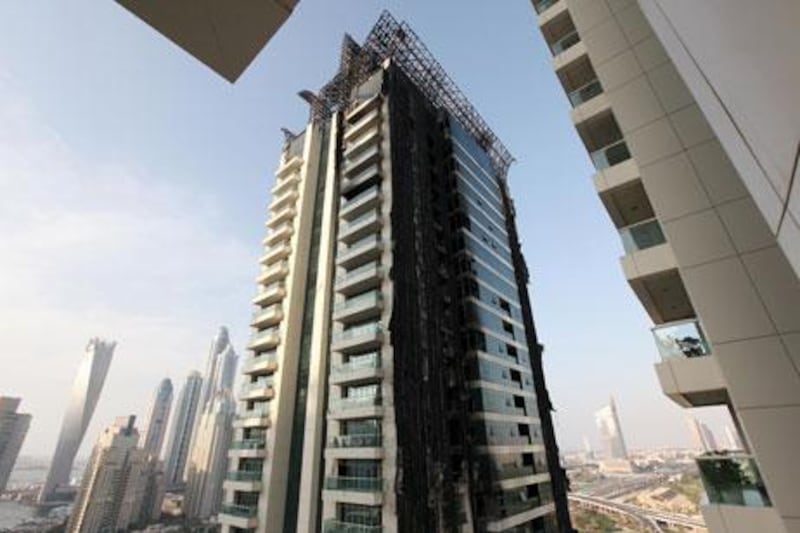DUBAI // Owners of high-rise buildings with flammable cladding will have to adopt new fire-safety measures under rules announced by Civil Defence chiefs.
The rules, which will apply to existing towers and those yet to be built, include installing a ring of fire-retardant panels every three floors to stop fires spreading, and external sprinklers.
The measures are an extension of the Fire and Life safety code drawn up by the Ministry of Interior and introduced late last year.
Maj Jamal Ibrahim, director of the preventive safety department of Dubai Civil Defence, said the new code needed to apply to existing buildings, not just new ones.
“In existing buildings we have been trying to find solutions that are not too costly for the owner, or that will cause the building to close,” said Maj Ibrahim. “We just want more safety requirements.
“One is outdoor sprinklers. Another is to have fire-retardant cladding every three floors.”
It is believed that about 70 per cent of high-rise buildings in Dubai use cladding with a highly flammable thermo-plastic core.
“Also, there are more general safety issues,” Maj Ibrahim said. “No barbeques, shisha or gas cylinders. This will stop any cause of the fire.”
The new rules were announced at the Fire Safety, Standards and Regulations Forum at the Dubai World Trade Centre.
While most towers have indoor sprinklers and fire hoses, very few have a means of controlling a blaze if it spreads to the outside.
Maj Ibrahim said there was, as yet, no deadline for building owners to implement the new measures.
“We are still working on it,” he said.
This week Arab Orient, the insurer of Tamweel Tower in Jumeirah Lakes Towers (JLT), agreed to pay for damages caused in the fire that destroyed one side of the 34-storey building in November last year.
Owners of apartments were unsure whether the payout would cover the cost of replacing all of the cladding panels with fire-resistant ones, or just those damaged in the blaze.
But Maj Ibrahim said regardless of who paid for the repairs, as the building had been damaged by fire the cladding on the entire tower must be replaced by new, safety-tested panels.
“There must be new cladding across the whole building,” he said. “As soon as there’s a fire, it must be all completely replaced.”
He said he would this week meet an official from Trakhees, the authority that regulates free zones such as JLT, about the issue.
A discarded cigarette butt is thought to have ignited rubbish piled up outside Tamweel Tower, according to a report compiled by the Dubai Police forensic department.
It found the November 18 fire, which gutted half of the tower block, began in a pile of paper, tape and wood in an outdoor passageway at the base of the building. It had been left there by contractors working on a shop inside the building.
Once lit, the fire quickly spread up the highly flammable building cladding, which contained aluminium and fibreglass, to the roof.
From there, blazing chunks of cladding rained on the balconies and cars below. The fire spread inside the building mainly through the balconies.
Dr Sarah Colwell, head of suppression at the UK fire research company BRE Global, conducted research on flammable cladding 1990s after a number of related fires.
Speaking at Intersec, Dr Colwell said extensive testing and modelling should be carried out before before safety systems such as external sprinklers were installed to ensure they were effective.
“There are potentially a number of different approaches and it would be a case of just looking at each one individually”, she said.
"What needs to be done is an assessment on how that would work on that particular design, and looking at whether they can use it on that building in practice. All of that needs to be looked at."
mcroucher@thenational.ae






